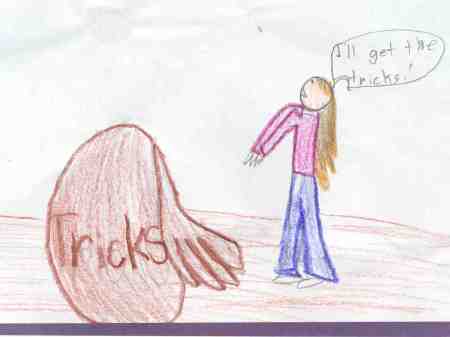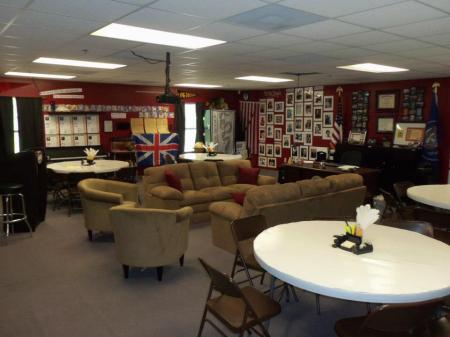It’s been almost a month since I posted so I wanted to share two emails from our high school team that may be un-hyperbolically the greatest recaps of charter school sporting events ever. They also speak to the staff and student culture in a marvelous and goofy way.
Today the cross country meet(ing) schedule called for a footrace at Sheepfold. Last week was Breakheart. Now Sheepfold. It is almost like the universe is daring us to be epic.
Be comforted by the fact that your dear Panthers never, ever fold. And they are quite decisively NOT sheep.
The bus was scheduled to pick us up at 2:30. At 2:45, we decided that the bus being late was really a great opportunity to take a team picture out in the drizzle. Spirits were high. At 3pm, the coaches began to wonder if things were amiss. Sheepfold, they were told, was at least 40 minutes away if traffic wasn’t too bad. At 3:15, after they had missed all of 7th period, the team gathered to commiserate over the needlessly lost instructional time and to discuss the possibility of not making it to the meet. Prayers were said silently, and Edivan shook his fists at the rain. Coach Bertrand(The coach of today’s Middle school champ, Tayjuan), assistant coach DoBell, and Head Coach (he told me I had to capitalize it) Lindemann discussed the question: If the bus pulls up right now, do we get on it? Smoke was seen coming from the ears of Coach McClendon.
The cross country season is 5 meets long. If we miss a race, it is 20% of the season. That’s like two tenths of the season.
At 3:25, we boarded the bus, Panthers, unsure of what would greet us on the horizon. Coach DoBell was very nervous.
I’ll say this, our driver drove like we were trying to get somewhere.
And thank God she did, because somewhere is where we got.
At 4:00 we were pulling into the Sheepfold lot and the Panthers were pulling off their warm-ups (mismatched hoodies and pajama pants). Coach DoBell sprinted heroically to where his impressive instincts told him he would find a man holding a manilla envelope containing our team’s bib numbers. As he rounded a turn in the trail, his heart sank. The other teams were already on the line. These gutless wonders were about to run without us. Cowards! — I was told we had about 60 seconds to get on the line.
Behind Coach DoBell trotted the mighty panthers, safety pins in hand. (Lindemann actually thought to bring safety pins. Who is this guy?) Numbers were distributed and pinned as we walked/jogged to the line. Someone fell and became muddy. Did I mention it was still raining?
A note about this: going straight from a bus ride to an all-out 3 mile race with no warm-up is a bad idea for a number of reasons, not the least of which is risk of injury.
The gun (whistle) went off and they were off. The coach for the falcons and the coach for the other panthers made a wager about how many kids would fall in the mud. Chuckles were heard. Chuckles. As though this event was simply diversion.
At the mile mark Edivan was about 5th, followed by Nick, Sheneil, Jose, and Andres. Anaidys was up near Sheneil about 40 yards behind the girls leader, who looked a bit like a deer. Anaidys, luckily, had the look of a predatory cat. Precious wasn’t far behind, running alone and running strong. Then Jacob, followed by Roody, Eric F, Gilda and Olga, Ernesto, Amilcar, Es, and Ann came through. Most had a mixture of alarm, pain, and exhilaration in their eyes. Then Amayrani came through, looking like she was having no fun, but perhaps doing what she wanted to be doing.
Then Brendan and Mercedes came through. Mercedes was quite muddy. As they passed by, she said, “I fell in the mud, but I’m OK.” What a great example of what we want our kids to say about a challenge!
Then all of them returned to the woods to complete a big loop. We didn’t see them until they finished.
Times (unsure of the exact measurement – The guy in charge said 3.09 miles. He was wrong.)
Edivan 16:02
Nick 17:26
Andres 18:20
Sheneil 18:24
Jose 18:40
Jacob 19:45
Roody 19:50
Eric F 20:41
Ernesto 20:46
Amilcar 22:55
Brendan 32:15
Anaidys 18:45
Precious 20:46
Gilda 22:00
Olga 22:40
Ann 24:17
Amayrani 29:21
Mercedes 32:33
Finish line highlights:
Taking the final turn into the finish, Jose screamed a primal scream and, with a blistering kick, caught a Falcon and white guy in green. He may have been a spartan.
Anaidys came out of the woods with a large lead on the girl who was leading earlier and who had won the first meet. Anaidys was ROLLLING, kept the lead and finished with the sort of kick that is not possible with regular sized heart. Then she congratulated the second place girl.
Sheneil who limped by me with 80 yards to go, broke into an impressive limp-sprint, holding on to valuable team points, holding a few guys off. (Cross country is scored like golf. Low team score wins. 1st place is one point. 50th is 50 points. Each team scores 5 runners)
Precious. In the last straight, Precious was behind a couple girls and got passed by a guy. Then she kicked. She dusted them. Precious says NO! Awesome. Later, on the ride home, she and I would spend about 20 minutes debating whether chili is a soup.
Amayrani came out of the woods with her glasses in her hand. She was running alone with feet that were muddy and eyes that were asking the big questions.
Then the Middle School race, where our own Tayjuan CRUSHED everyone. This kid is the man. After his victory, a limping Sheneil, probably the only guy present who could make Tayjuan look like a middle schooler (because he is a big strong dude), put his arm around him and raised his other fist to the sky in shared KIPP victory and glorious team and family-ness.
As was the case last week, our kids were the major cheerers for the middle school race. Other high schools are apparently too cool to cheer for them. COWARDS!
Seriously, all of our kids, tired, muddy, wet, and bloody (3 of them) were cheering for all the middle school kids that came by. Anyone want to be happy? Enter the middle school race and run by Olga and Ann. Our kids are the coolest kids in the world.
A great detail: After hearing from Coach Lindemann about the exfoliating properties of mud, Olga became excited and led a charge toward the mud bog, yelling, “Mud Party, WHOOOOOO!” No one followed, but everyone agreed that it was very funny.
Dobell’s efforts inspired our sophomore counselor and soccer coach Liz Faira to write the following:
Panthers 1, Salem Academy 0
While the level of sheer epic-ness reached by KALC cross country is hard to attain, girls soccer reached new heights of skill and guts today, well worth a recap. DoBell, thanks for the inspiration to document the greatness of our scrappy little athletes!
Big win today. Huge. A 1-0 victory over Salem Academy, who were rumored to be a pack of trash-talking thugs. Coach was on hand and gamely volunteered to step in if anyone got crazy and amped up their vulgar language to 11, but that proved irrelevant, as the new mouth-guard requirement makes it impossible for anyone to say anything at all. It also prevents our girls from breathing, but that’s another story. Egbe’s mouth-guard protrudes past her lips to such an extent that I’m fairly sure she’s holding an entire helmet, two retainers and some bubble wrap between her teeth.
As for Salem, several of their players were thought to be carrying nunchucks, which mercifully turned out to be shin pads. Their goalie was a seventh grader who made Dulce Gonzalez look like the Incredible Hulk. The intimidation factor was minimized by the sheer wee-ness of this goalie. Not that our girls seemed particularly intimidated at any point. Indeed, the main focus of the pre-game “warm-up” (a term I use lightly) was the fact that Tarra frantically needed to get her hands on some Vasoline because, oddly, she had just showered and was not properly moisturized for the game. She was ashy! This dilemma trumped all other physical concerns, including Alex’s bad ankle and the fact that Amie was in need of an iron lung.
Our girls were forced to play shorthanded (down between 1 and 3 players all game, varying based on the revolving needs of our asthmatics). MiKayla, sick to the point of pinning her eyes open with clothesline pins, pulled off an impressively gritty game, playing every minute without respite and playing hard. Being threatened by a screaming Helen at sweeper may have helped this commitment along.
Alisha, who just days ago collided with a rival player and was subsequently examined by 8 EMTs and the cast of Grey’s Anatomy under the glaring lights of Manning, was back in action and taking hit after hit. This either speaks to her tenacity or to the fact that her previous injury perhaps didn’t warrant the attention of the entire Lynn Fire Department. Nonethless. That kid is like a brick house on the field. Her back is composed solely of steel rods. This makes airline travel difficult but makes her an effective defender.
It’s hard to pick the biggest star of the game, the contenders being Mariangeliz (with the lone goal!), Alex (totally controls the field!), Helen “The Wall” Maldonado (nothing gets past this kid – unless it’s a faster kid…but that’s rare!) Briana (10 saves in goal, one amazing save in the final minutes!), or Bekemeh. “Wait a minute!” you may be saying to yourself, “Bekemeh is in my class and is not eligible to play!” That is correct. Bekemeh, affectionately known as “The Mouth,” is a contender due solely to her sideline commentary, which is typically a hybrid of ecstatic and completely insane. Bekehmeh is often shrieking at a decibel only dogs can hear, but periodically peppers her screams with completely random tidbits For example, my personal favorite from today does not *entirely* relate to soccer. And by that I mean it has nothing to do with soccer in any way. Rather, as I am focusing on the field and trying to coach (since I am the coach), I am distracted as all I can hear behind me is the following gem: “Do you know in NYC people can volunteer to be castrated??” This is followed by Zinara asking me if I can give Bekemeh a demerit for being annoying.
In any event, the girls picked up a well-earned win today, holding on to the lead from Mariangeliz’s nicely placed goal late in the first half. That kid has wheels! Our defense, led by a stellar Briana (Player of the Game) in net and Helen as a take-no-prisoners sweeper, played tight all game. So we are now 3-2 on the season, but keep in mind that one of the losses was a forfeit due to the elements (“the elements” being light rain, yes). But rain can turn into thunder and thunder to lighting and lightning to imminent death. So, I think we made the right call. In any event, the KALC Panthers are now officially 3-2 which is amazing for several reasons, not the least of which is the fact that just weeks ago over 75% of our team was catching the ball with both hands repeatedly during practice, arguably our best player was wearing moccasins to scrimmages, and I had to physically usher players to their respective positions, as they had no idea what any of the positions were.
As an aside, we should be very ready for basketball season – just today Nicole got called for an illegal throw-in after doing a basketball-style push pass into play, rather than the traditional (read, legal) overhanded soccer throw-in that we have gone over at least 100 times at this point. Nat, Riley, B-Ball fans everywhere – start your engines! (in a month or so).
Go Panthers!
Coach Faria
















